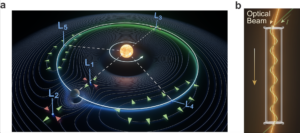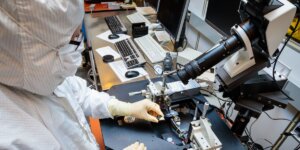
Celestial and optical beam dynamics in the vicinity of a stable Lagrange point. a) The five Lagrange points in the Sun-Jupiter system. b) Experimental setup used to observe optical Trojan bound states (bright yellow beam). A stable Lagrange point is established via the thermo-optic effect. (Illustrations: Yunxuan Wei)
USC Viterbi School researchers have reported the first observation of an exotic class of guided optical waves called Trojan beams. Counterintuitively, these photonic wavefronts are trapped in nowhere land – in completely inconspicuous regions where no conventional waveguide structures exist. What enables this unexpected behavior is the presence of optically induced Lagrange points, the same stable positions that are responsible for capturing the Trojan asteroids in the Sun-Jupiter system.
The findings were detailed in a new article in the journal Nature Physics.

Mercedeh Khajavikhan
Lagrange points were first predicted by the mathematicians Leonhard Euler and Joseph-Louis Lagrange in the 18th century within the context of celestial mechanics. At these positions, the gravitational forces of two massive bodies balance the centrifugal force exerted on a smaller planetoid. Already, some of these Lagrange points (L_1,L_2) are used by several agencies as “parking spots” in space, allowing satellites to maintain a stable position with minimal fuel consumption, as in the case of the James Webb telescope and the recently launched Aditya L1 spacecraft.

Demetri Christodoulides
But perhaps the most peculiar of these are the L_4 and L_5 Lagrange points, where Trojan asteroids, say in the Sun-Jupiter orbit, can be indefinitely captured by means of Coriolis forces. It is exactly these points that the USC team has deployed for experimentally demonstrating optical Trojan beams. The research teams, led by Professors Mercedeh Khajavikhan and Demetri Christodoulides of the Ming Hsieh Department of Electrical and Computer Engineering, hope that these unusual features may enable Trojan beams to be used in optical settings where traditional guiding approaches are not possible — such as in liquid and gaseous systems.
The graduate students and postdocs involved in this study, Haokun Luo, Yunxuan Wei, Fan Wu, and Georgios Pyrialakos, induced the optical Lagrange points using twisted helical arrangements in cured silicon oil cylinders by exploiting their large thermo-optic effect. According to Khajavikhan, this is an easily repeatable process, as demonstrated in this video:
“Interestingly, the resulting optical Trojan beams were captured even in defocusing environments at points where the refractive index profile (within the stationary frame) is totally ordinary—with no features that could foretell a guiding behavior,” said Christodoulides, the Steven and Kathryn Sample Chair in Engineering at ECE (Systems).
Khajavikhan, the IBM Early Career Chair at ECE (Electrophysics), added: “Our work demonstrates that this process can trap light in a way that was not previously imaginable. These findings may have implications beyond standard optical waveguiding schemes and could universally apply to other wave systems such as acoustics and ultracold atoms. It is always fascinating to see how concepts that emerged in unrelated fields like celestial mechanics can be put in use in other areas like optics.”
More information:
- Luo, H., Wei, Y., Wu, F.O. et al. Guiding Trojan light beams via Lagrange points. Nat. Phys. (2024). https://doi.org/10.1038/s41567-023-02270-6
- Tyc, T., Čižmár, T. Optical Coriolis force guides light along Trojan beams. Nat. Phys. (2024). https://doi.org/10.1038/s41567-023-02251-9
Published on January 5th, 2024
Last updated on May 16th, 2024












